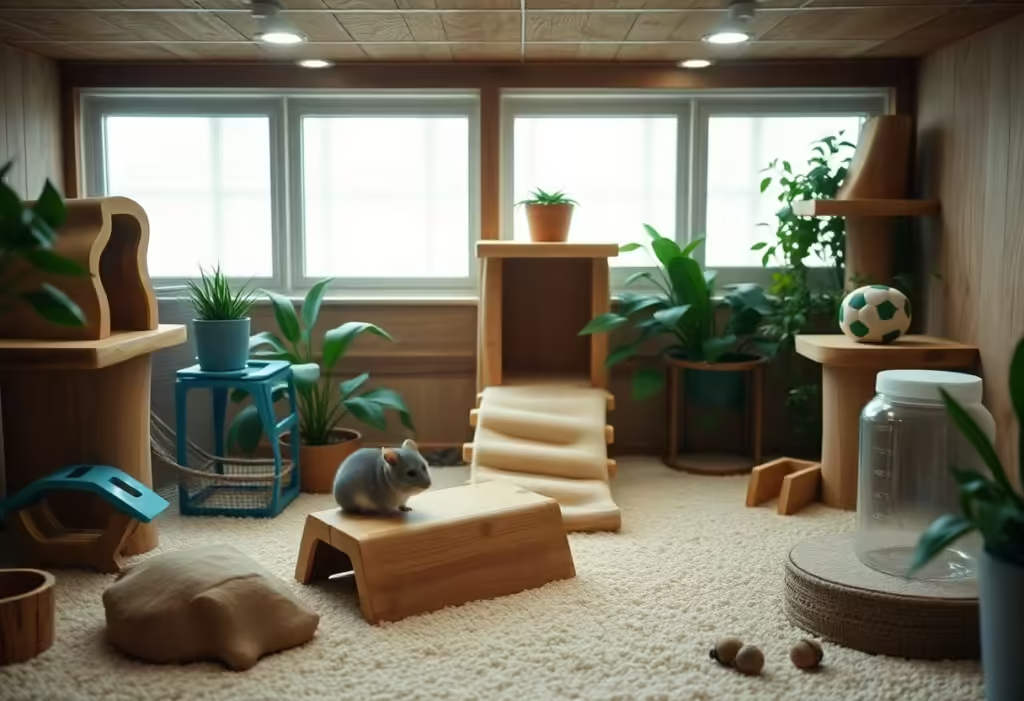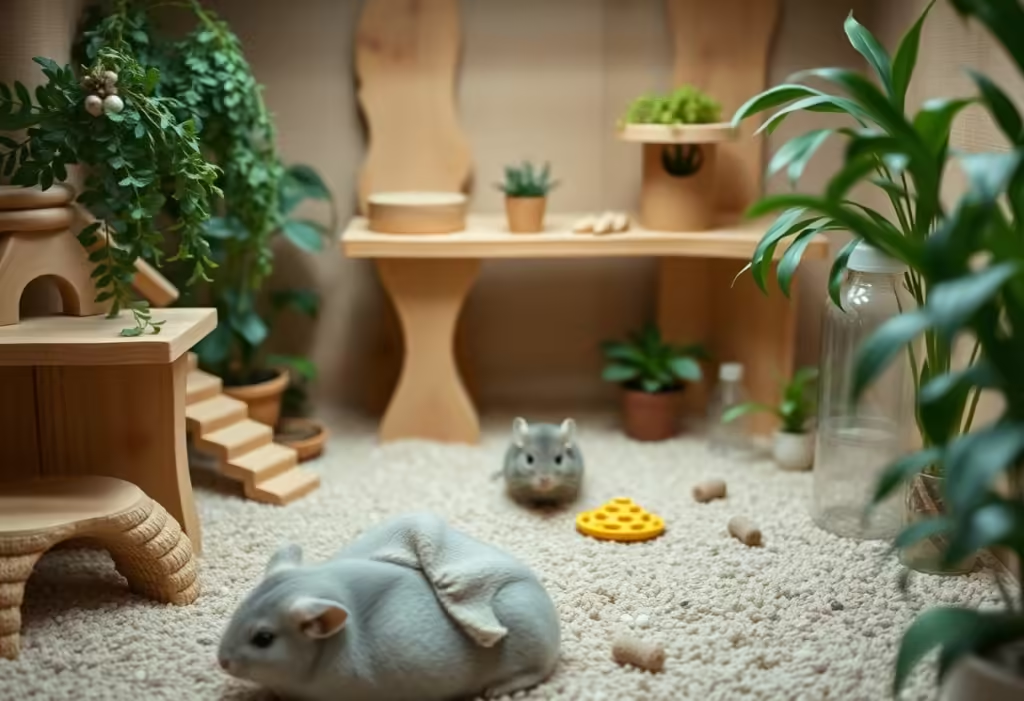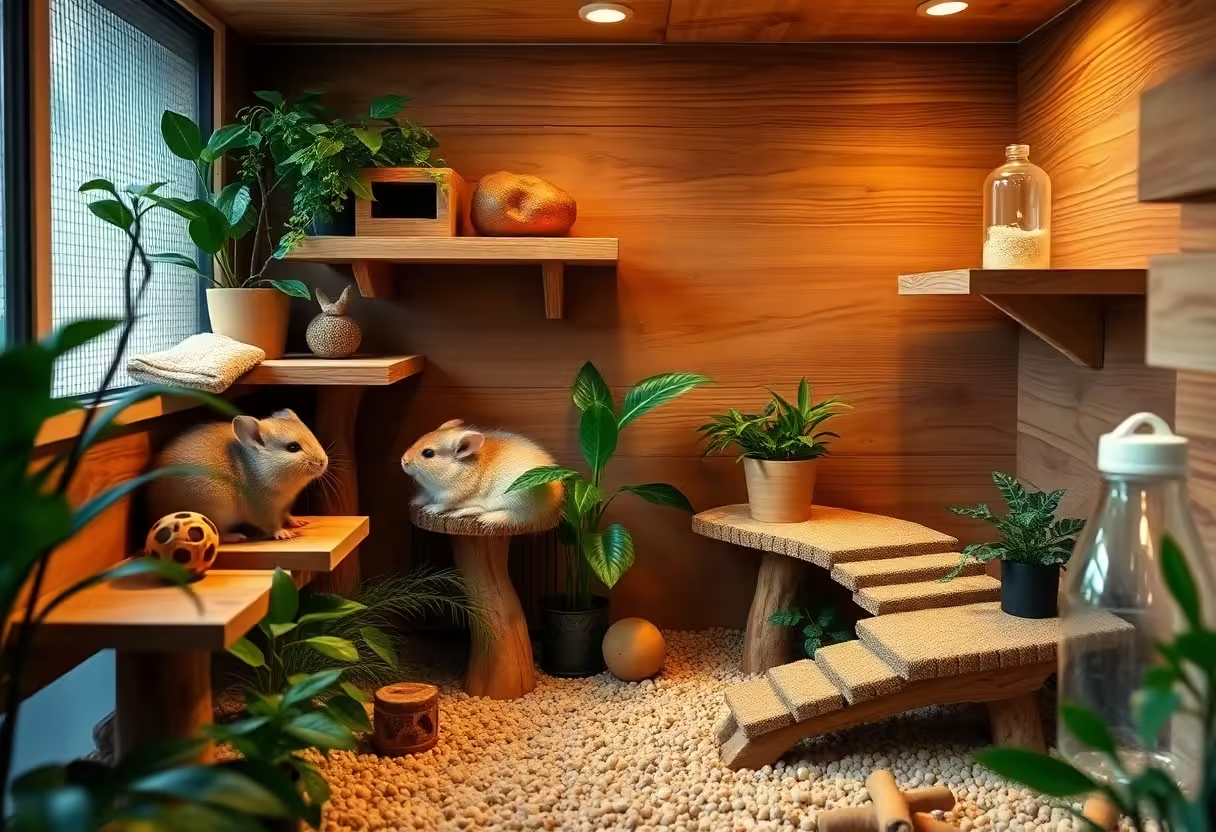Creating the perfect habitat for your chinchilla is not just about comfort—it’s essential for their health and happiness. A well-designed environment can prevent common health issues and stimulate natural behaviors. By focusing on the right habitat setup and avoiding common mistakes, you can provide a safe, comfortable, and enriching home for your chinchilla, promoting their overall well-being.
Key Takeaways
- Space Requirements: Choose a spacious habitat with plenty of room for jumping and climbing. Minimum dimensions should be 24 inches wide, 24 inches deep, and 36 inches high.
- Temperature Control: Maintain a cool environment. Chinchillas are sensitive to heat and should be kept in temperatures below 75°F.
- Bedding Material: Use safe bedding such as aspen shavings or paper products; avoid cedar or pine shavings that can release harmful oils.
- Climbing Structures: Incorporate shelves, ramps, and vertical elements. Chinchillas love to climb and explore at different heights.
- Diet Accessibility: Ensure hay and fresh water are easily accessible, as a proper diet is crucial to their health.

Understanding Chinchilla Needs
To design an ideal habitat, it’s important to understand the chinchilla’s natural environment. Native to the Andes mountains in South America, chinchillas thrive in cool, dry conditions. Their natural habitat is rocky, which explains their love for climbing and exploring. Mimicking these conditions in your home will help your chinchilla feel more comfortable and allow them to express natural behaviors.
Natural Habitat Characteristics
In the wild, chinchillas live in cool, high-altitude environments filled with rocks and crevices. They are excellent climbers and love to jump and explore different levels of terrain. To meet these needs in captivity, it’s essential to include multi-level structures and hiding spots within their habitat.
Key Features of Their Natural Habitat
- Cool, dry temperatures: Between 60°F to 70°F.
- Vertical exploration: Climbing and jumping are part of their natural behavior.
- Hiding spots: Chinchillas need places to hide and feel secure.
Key Environmental Factors
To ensure your chinchilla’s comfort and health, it’s essential to control the environmental conditions of their habitat. Below are the most critical factors to consider:
Temperature Control
Chinchillas are highly sensitive to heat. Maintain a temperature range of 60°F to 70°F, and avoid going above 75°F, which can cause overheating.
Humidity Levels
Keep the humidity low, ideally between 30% and 50%, to prevent respiratory problems. High humidity can also affect their fur, making it damp and prone to infection.
Ventilation
Good airflow is crucial. Ensure proper ventilation in the cage to prevent moisture buildup and allow fresh air circulation without exposing your chinchilla to drafts.
Choosing the Right Cage
The first step in designing a great habitat is selecting the right cage. Chinchillas require large cages with plenty of vertical space to explore. Opt for a cage made of durable, non-toxic materials that can withstand your chinchilla’s natural chewing instincts.
Size and Space Requirements
For one chinchilla, the cage should be at least 24 inches wide, 24 inches deep, and 36 inches high. Larger is always better, as chinchillas are very active and need space to move around.
Material and Design Considerations
Choose cages made from metal bars, as plastic can be easily chewed, posing a health risk. Ensure the bar spacing is no more than 1 inch apart to prevent your chinchilla from escaping. The floor should be solid (not wire) to protect their delicate feet.

Bedding and Nesting Options
Chinchillas need safe, comfortable bedding that absorbs moisture and controls odor. Opt for non-toxic materials that won’t irritate their sensitive respiratory systems.
Safe Bedding Materials
Aspen shavings, paper-based bedding, or special chinchilla bedding are the best options. Avoid cedar or pine shavings, which release oils that can irritate a chinchilla’s respiratory system.
Nesting Structures
Provide your chinchilla with cozy nesting areas like wooden huts or hammocks. These mimic their natural need to hide and rest securely.
Avoid Harmful Materials
Avoid any bedding or nesting materials that produce dust or contain toxins, as these can negatively impact your chinchilla’s health.
Enrichment and Play Areas
Keeping your chinchilla entertained is essential for their mental well-being. Regularly rotating toys and introducing new elements to their habitat will keep them engaged and prevent boredom.
Suggested Toys and Activities
Chinchillas love to chew and climb. Provide chew toys made from safe wood, tunnels for exploring, and platforms for climbing.
Safe Climbing Structures
Include ramps, platforms, and vertical elements to encourage jumping and climbing. Make sure these structures are secure and made from non-toxic materials.

Common Mistakes to Avoid
Even well-meaning chinchilla owners can make mistakes that impact their pet’s health. Avoid the following:
- Poor Cage Location: Placing the cage in direct sunlight or a noisy, high-traffic area can cause stress and overheating. Choose a quiet, shaded location with good airflow.
- Inadequate Diet: Feeding too many sugary treats or fruits can cause digestive issues and lead to obesity. Stick to a diet of high-fiber hay, quality chinchilla pellets, and limited treats.
- Improper Bedding: Cedar and pine shavings release toxic oils. Always opt for safe alternatives like aspen or paper-based bedding.
Maintenance and Care of the Habitat
Regular cleaning is essential for maintaining a healthy chinchilla habitat. Dirty bedding or uneaten food can attract bacteria and pests, posing a health risk.
Cleaning Routine
- Daily: Spot clean for waste, food, and dirty bedding.
- Weekly: Replace all bedding and thoroughly clean the cage with a safe disinfectant.
Monitoring your chinchilla’s environment for moisture, droppings, and temperature fluctuations will help prevent any potential health issues.
Regular Health Monitoring
Keep an eye on your chinchilla’s weight, fur condition, and behavior to spot any health issues early. Regular health checks ensure they stay in peak condition.
Conclusion
Designing the perfect habitat for your chinchilla involves more than just choosing a cage—it’s about creating a space that promotes physical activity, mental stimulation, and overall well-being. Focus on providing ample space, proper ventilation, and safe enrichment options to keep your chinchilla happy and healthy. Regular cleaning and monitoring ensure that your chinchilla’s environment remains hygienic and comfortable. By following these guidelines and avoiding common mistakes, you’ll create a habitat that allows your chinchilla to thrive.
Take action today by reviewing your chinchilla’s current setup and implementing these improvements for a healthier, happier pet!
FAQ
What is the ideal size for a chinchilla habitat?
The ideal cage size should be at least 24 inches wide, 24 inches deep, and 36 inches high for one chinchilla. Always aim for larger if possible, as chinchillas require vertical space for jumping and climbing.
What type of bedding is best for a chinchilla habitat?
Use aspen shavings, paper-based bedding, or special chinchilla bedding to manage odor and absorb moisture. Avoid cedar or pine shavings as they can release harmful oils that irritate the respiratory system.
Should I include a litter box in my chinchilla’s habitat?
Yes, chinchillas can be trained to use a litter box. Use paper-based or chinchilla-safe litter and place the box in a consistent corner of the cage.
What types of enrichment should I provide?
Include plenty of chew toys made from safe wood, tunnels, and climbing platforms. Hide treats in different spots to encourage natural foraging behaviors and regularly rotate toys to keep your chinchilla mentally stimulated.
Are there any plants or materials to avoid?
Avoid toxic plants like ivy and philodendron, as well as plastic toys or items with small parts that could be ingested. Stick to natural, non-toxic materials.
